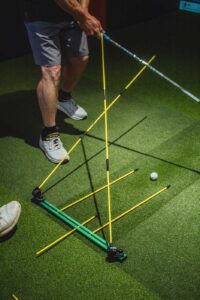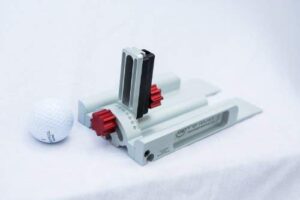The Pureplane Pro Gen 3 Review: Can This $65 Plastic Base Really Fix Your Slice?
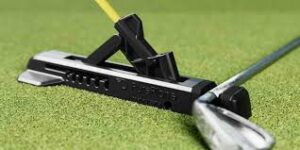
Birdie Score
One-Putt Summary
A decent solution to mat practice limitations that is pretty simple to use, but requires a golf club to weigh it down and with limited versatility.
Fairways (Pros)
- ✓ Effectively lets you hit off mats
- ✓ Alignment sticks are a sound training tool
- ✓ Portable
Hazards (Cons)
- ✗ Requires your club to help prevent tipping over
- ✗ Alignment stick holder, no other drills
- ✗ Overpriced for what it is
Best For
Mid-to-high handicappers with diagnosed swing path issues who practice primarily on mats
Pureplane Pro Gen 3 Review: The Truth About This $65 Swing Plane Trainer
The Pureplane Pro Gen 3 sits in a peculiar position in the golf training aid market: it receives near-perfect ratings from buyers but fierce skepticism from the broader golf community. With an average rating of 4.81 out of 5 stars on the manufacturer’s website and perfect 5-star reviews on retailer sites, you’d think this device is universally beloved. Yet venture into golf forums and Reddit threads, and you’ll find a very different story—one dominated by questions about value, DIY alternatives, and warnings about unsupervised use.
This review cuts through the contradictions to deliver the unvarnished truth about the Pureplane Pro Gen 3: who it actually works for, what it genuinely fixes, and whether it’s worth your money when cheaper alternatives exist.

What the Pureplane Pro Gen 3 Actually Is (And Isn’t)
Strip away the marketing language, and the Pureplane Pro Gen 3 is a weighted plastic base designed to hold an alignment stick at adjustable angles (40°-70°) while anchored by a golf club. That’s it. The device doesn’t measure anything, doesn’t provide data, and doesn’t connect to your phone. It’s a sophisticated stick holder—but that simplicity is precisely what makes it either brilliant or overpriced, depending on your perspective.
The core innovation isn’t the device itself but what it enables: swing plane drills on mats and indoor surfaces where traditional alignment sticks cannot be anchored. This single function explains both the passionate support from certain golfers and the derision from others who practice exclusively on grass.
The Product Lineup Breakdown
Pure Plane Pro Gen 3 (Device Only): $65.00 — Requires you to provide your own alignment sticks
Pure Plane Pro Gen 3 + Standard Alignment Sticks: $75.00 — Includes full-length sticks for outdoor/large space use
Pure Plane Pro Gen 3 + Mini Alignment Sticks: $75.00 — Includes 26-27″ compact sticks designed for indoor practice and improved stability
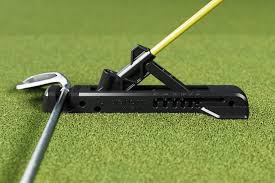
Build Quality: Lightweight by Design, Flimsy by Reputation
Material Construction and Durability
The Pureplane Pro Gen 3 features injection-molded plastic construction with a metal pin adjustment system for changing angles. The device is deliberately lightweight—designed to fit easily into a golf bag and travel to multiple practice locations without adding significant weight. This design philosophy immediately creates a tension between portability and perceived substance.
Here’s the paradox that defines user reactions: despite widespread descriptions of the device as “flimsy” and “a bit light,” there are zero reported cases of the device breaking, cracking, or failing structurally. The psychological perception of cheapness exists alongside functional reliability. Users who appreciate portability praise the design; those who value heft criticize it as insubstantial.
The Durability Verdict
✓ What holds up:
Zero breakage reports despite widespread use. The metal pin system shows no failure mentions. Component integrity remains intact even with regular practice sessions.
✗ What doesn’t inspire confidence:
The lightweight plastic construction creates a psychological barrier for some users. Multiple reviews describe it as feeling “insubstantial” despite no functional failures. The perception problem is real even if the durability concern isn’t.

Build Quality Score
Functionally reliable despite perception issues
16/20
Effectiveness: What It Actually Fixes (With Critical Caveats)
The Pureplane Pro Gen 3’s effectiveness is both its greatest strength and the source of its most serious concerns. The device excels at providing immediate, tangible feedback for specific swing faults—but only when used correctly by golfers who understand exactly what they’re trying to fix.
Primary Swing Fault: The Over-the-Top Move
The Sweet Spot Application
The Pureplane Pro Gen 3 receives its most consistent praise for correcting the over-the-top swing motion—the primary cause of slicing. Users report that the physical barrier of the alignment stick forces them to drop the club into the proper slot on the downswing, creating an inside-to-out path instead of the destructive out-to-in pattern that produces weak slices.
One user documented changing their path to 3.5-4.8° in-to-out on a launch monitor after dedicated practice. Multiple instructors demonstrate this specific drill in YouTube content, validating it as the device’s core competency.
Secondary Applications
Other Documented Fixes:
- ✓ Shallowing the club: Helps golfers transition from a steep downswing to a shallower, more efficient path
- ✓ Inside takeaway correction: Provides visual reference for keeping the club on the proper initial path
- ✓ Early extension: Using the vertical slot helps golfers maintain posture through impact
- ✓ Getting stuck: Addresses excessive in-to-out paths that cause blocks and hooks

The Professional Guidance Requirement
⚠️ CRITICAL LIMITATION: Risk of Ingraining New Faults
Here’s the most serious concern raised by experienced golfers and instructors: Because the Pureplane Pro is so effective at providing feedback and encouraging repetition, using it with an incorrectly set angle can efficiently ingrain a new, potentially worse swing fault.
One Reddit user issued a stark warning: “I would probably stay away from a training aid like this unless you’re working closely with an instructor doing these specific drills. Not worth the chance of this messing up your swing trying to hit random angles you set yourself.”
Even users who report success emphasize professional oversight. One golfer stated: “I liked it a lot to help me shallow out, but I was using it with a coach. He was the one who set the correct angle and watched me to make sure I was using it properly.”
The Conspicuous Absence of Objective Data
Despite extensive research across reviews, forums, and user testimonials, zero users provided measurable, quantified improvements such as:
- ✗ Launch monitor data showing before/after club path changes
- ✗ Handicap reductions tracked over time
- ✗ Strokes gained data from course performance
- ✗ Long-term success stories (“I used this for 3 months and my handicap dropped from 18 to 12”)
All reported improvements are qualitative and feel-based. The device appears to function primarily as a drill reinforcement tool rather than a measurable swing transformation system.
Effectiveness Score
Highly effective for specific faults with proper guidance; risky without
21/30
Ease of Use: Simple Concept, Stability Headaches
✓ Setup Speed and Portability
Once you understand the system, setup takes 2-3 minutes: position the device relative to the ball, select your angle setting, insert the alignment stick, and anchor with a club. The Gen 3’s compact size means it genuinely fits in your golf bag without dominating space.
“Super lightweight and easily fits in a golf bag” — Multiple user reviews
✗ The Stability Problem
This is the most frequent functional complaint: Even with proper club anchoring, users report the device tips over when the alignment stick is inserted or during practice swings.
One user bluntly stated: “Even with club setup, device falls over when alignment stick inserted.” The manufacturer acknowledges this requires specific technique—using an iron (not a wood) and resting the shaft properly in the designated channel.
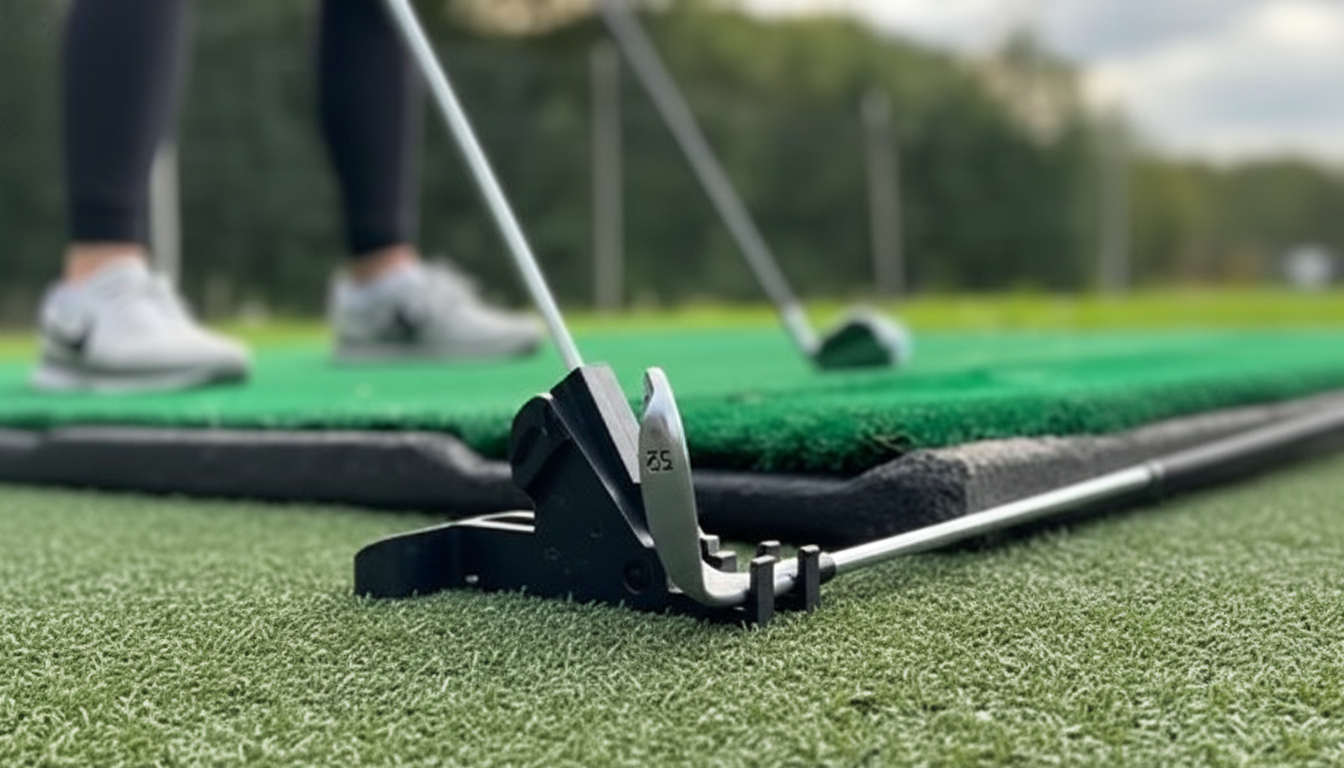
The Real Learning Curve
| Physical Setup | Easy once learned, but requires understanding the non-obvious anchoring technique |
| Angle Selection | Moderate difficulty—must understand which angle (40°-70°) matches your club and desired drill |
| Drill Selection | Challenging without instruction—8+ different drills for various faults; selecting the right one requires diagnosis |
| Pre-Round Warmup | Too cumbersome for quick 15-minute sessions; better suited for dedicated 45-60 minute practice |
Gen 3 Stability Improvement
The Gen 3 model bundled with Mini Alignment Sticks addresses some stability concerns. Reports indicate that when used with the included mini sticks (26-27″ long), the device “does not require the use of a club to anchor it.” This is a critical evolution that removes a significant friction point—though it only applies to the mini-stick bundle, not when using standard full-length alignment sticks.
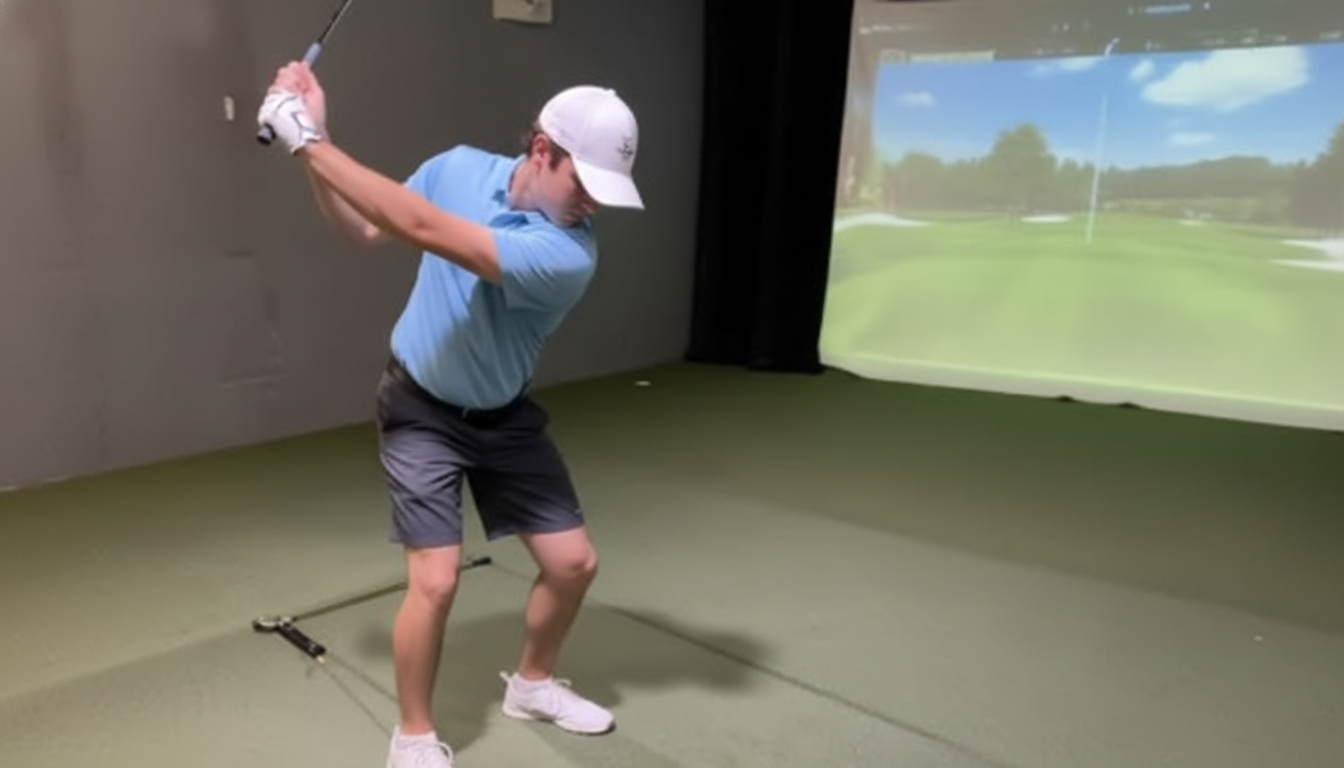
Ease of Use Score
Portable and quick setup undermined by stability issues
15/20
Value Analysis: The $65 Question and DIY Alternatives
Pureplane Pro Gen 3
$65-75
(device or with sticks)
EyeLine Speed Trap 2.0
~$100
(premium alternative)
DIY PVC Version
$6-20
(if you’re handy)
The Core Value Tension:
The function of the Pureplane Pro can be replicated by DIY methods. Reddit users describe building functionally equivalent devices from PVC pipes and fittings for $6-20. One user stated: “I made one out of a couple 1/2″ pvc pipes and various fittings. I just friction fit everything together so it’s easily adjustable. Use a pool noodle on it so it doesn’t fuck stuff up when you inevitably hit the stick.”
This widespread DIY movement isn’t just price criticism—it’s an active challenge to the product’s market position, suggesting its core function can be easily replicated by resourceful consumers.
How It Stacks Up Against Alternatives
| Feature | Pureplane Pro Gen 3 | Comparison |
| vs. Simple Alignment Sticks | $65-75 | Alignment sticks cost $10-15 and work equally well on grass. Pureplane’s advantage is only on mats where sticks can’t be inserted. |
| vs. Swing Plane Perfector | More portable | Similar function, different design approach. Check our full comparison review. |
| vs. The Swing Plate | Less versatile | The Swing Plate Dual Pro offers two adjustable stick holders and a heavier, more stable base preferred by coaches. |
| vs. WhyGolf Alignment Discs | Different approach | WhyGolf uses weighted discs with angle slots; heavier (5 lbs) but more stable. Check our comparison. |
Why Users Justify the Premium Price
Despite the availability of cheap alternatives, committed practitioners cite three justifications for buying the Pureplane Pro:
- 1. Convenience over DIY time investment: Not everyone wants to spend an hour building a PVC version or has the tools to do so effectively
- 2. Precise, repeatable angle settings: The numbered settings (40°-70°) provide consistency across practice sessions that DIY versions struggle to match
- 3. True portability: Fits in a golf bag and travels easily, unlike bulky PVC setups
Worth the Money If:
- • You practice primarily on mats (>75% of practice time)
- • You’re working with an instructor who recommends swing plane training
- • You value portability and convenience over cost savings
- • You’re not DIY-inclined or lack tools to build alternatives
- • You have a diagnosed swing path issue (not guessing)
Skip It If:
- • You practice on grass ranges where alignment sticks work fine
- • You’re comfortable building a PVC version for 75% less
- • Your swing fault is unclear or self-diagnosed
- • You’re not receiving professional instruction
- • Budget is extremely tight (DIY is vastly cheaper)
Value Score
Reasonable for target user; expensive vs. alternatives
14/25
Versatility: 8+ Drills From One Device
The Multi-Fault Capability
Unlike single-purpose training aids, the Pureplane Pro’s adjustable design enables multiple distinct drills for different swing faults:
Where It Actually Gets Used
- ✓ Mat-only driving ranges (primary value proposition)
- ✓ Indoor simulators and home practice spaces
- ✓ Post-lesson reinforcement of instructor-prescribed drills
- ✓ Full swing work with driver, woods, irons, and wedges
- ✓ Short game plane training for pitching and chipping
Versatility Score
Multiple applications from one portable device
5/5
Fairways & Hazards: The Complete Picture
Fairways (Strengths)
- ✓ Solves the mat practice problem where traditional methods fail
- ✓ Genuinely portable—fits in golf bag unlike bulky alternatives
- ✓ Multiple drill applications from single device
- ✓ Instant tactile feedback creates immediate awareness
- ✓ Zero breakage reports despite lightweight construction
Hazards (Limitations)
- ✗ Stability issues require specific anchoring technique
- ✗ Perceived as overpriced when DIY versions cost $6-20
- ✗ Risky without coaching—can ingrain new faults
- ✗ Zero objective performance data from users
- ✗ Redundant on grass ranges where sticks work free
FAQ: Your Pureplane Pro Gen 3 Questions Answered
Can I use this without a golf instructor?
Will this fix my slice immediately?
How does this compare to The Swing Plate or other alternatives?
Should I buy the device alone or with alignment sticks?
Why not just build a DIY version for $6-20?
Does it really tip over, or are users setting it up wrong?
Is this worth it if I practice on grass ranges?
The Bottom Line: Who Should (and Shouldn’t) Buy This
The Perfect User: “The Diagnosed Mat Driller”
Handicap Range: 15-30 (mid-to-high handicappers working on fundamentals)
You’re actively taking lessons from a qualified instructor who has diagnosed a specific swing path issue—most commonly an over-the-top pattern causing a slice, or an excessively steep/inside takeaway. Your coach has prescribed swing plane drills and given you specific guidance on which angles to use. You practice 2-4 times weekly, primarily at mat-only driving ranges, indoor simulators, or in your garage where traditional alignment sticks can’t be anchored.
Who Should Avoid: “The Unsupervised Grass Ranger”
- ✗ Grass range practitioners: You have regular access to ranges where alignment sticks can be inserted into the ground—making this device functionally redundant
- ✗ Self-diagnosers without instruction: You’re not currently receiving professional coaching and would be guessing which drill/angle to use based on ball flight alone
- ✗ DIY-capable and budget-conscious: You’re comfortable building a PVC version for $6-20 and value cost savings over convenience
- ✗ Sporadic practitioners: You practice less than once weekly and won’t commit to the thousands of reps needed for lasting change
- ✗ Data-driven players: You expect measurable, quantified improvements tracked on launch monitors—and will be disappointed by the absence of objective performance validation
Final Scoring
| Category | Score | Max |
|---|---|---|
| Effectiveness | 21 | 30 |
| Build Quality & Durability | 16 | 20 |
| Ease of Use | 15 | 20 |
| Value for Money | 14 | 25 |
| Versatility | 5 | 5 |
| TOTAL | 71 | 100 |
Solid “C+” Specialized Training Aid
The Verdict
The Pureplane Pro Gen 3 earns a 71/100 as a specialized tool that solves a specific problem exceptionally well for a narrow audience. It’s not a universal training aid, not a magic swing fix, and not the best value if cheaper alternatives work for your situation. But for mat practitioners working with instruction on diagnosed swing plane issues, it delivers genuine utility that justifies the cost. The 4.81-star buyer ratings aren’t deceptive—they represent satisfied golfers who recognized they were the target market before purchasing. The broader community skepticism represents golfers outside that profile questioning whether they should become customers. Both perspectives are valid; your practice environment and coaching situation determine which camp you belong in.
⛳ The 19th Hole: Final Verdict
A decent solution to mat practice limitations that is pretty simple to use, but requires a golf club to weigh it down and with limited versatility.
Birdie Score: 66/100

